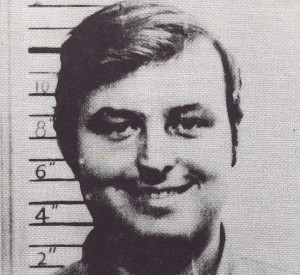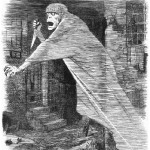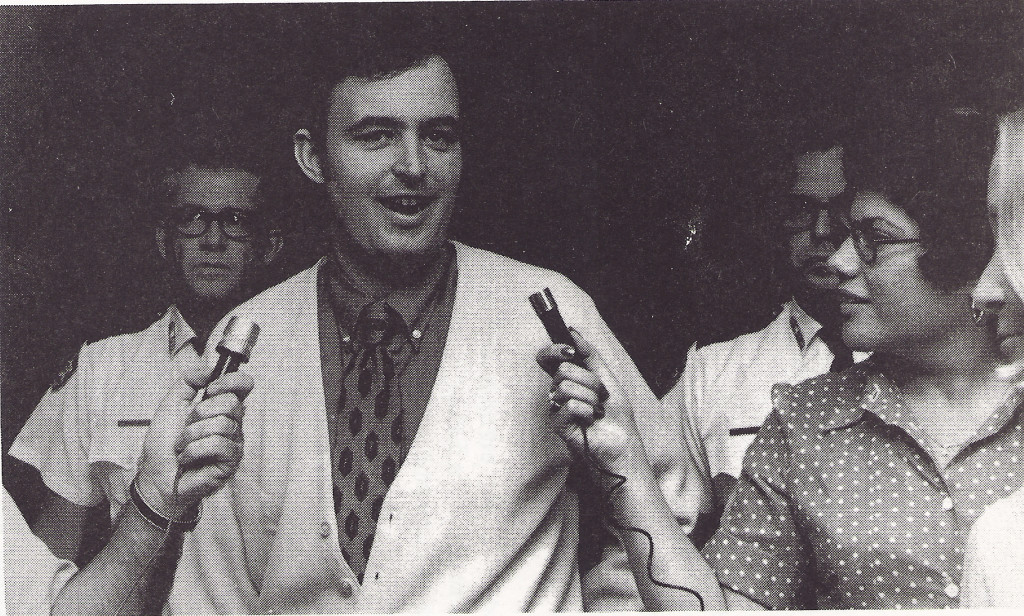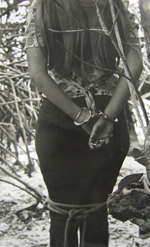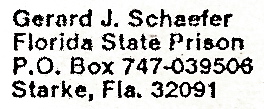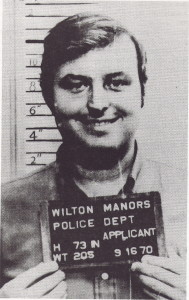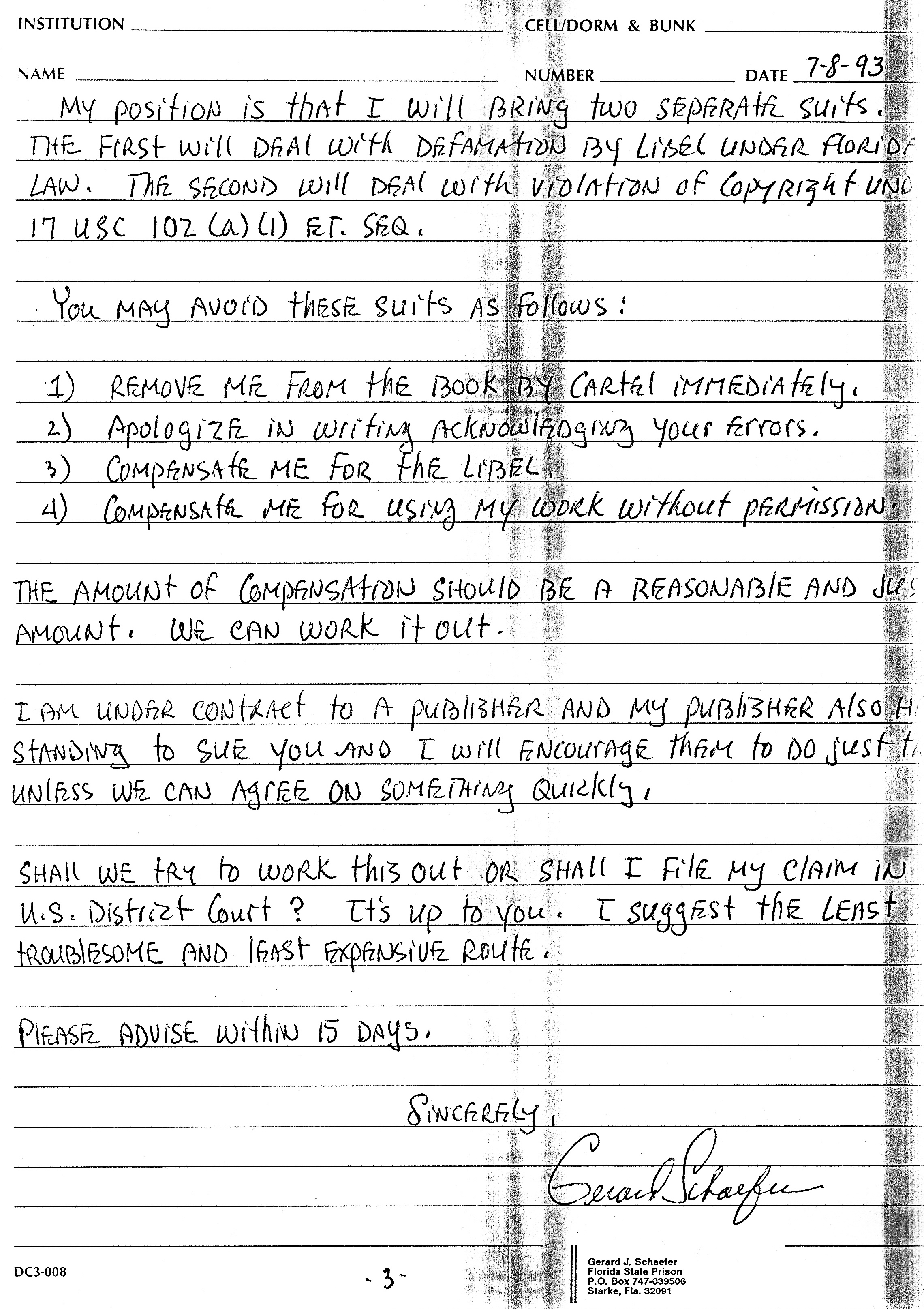Mike Cartel
Revised from DISGUISE OF SANITY Pepperbox Books © Michael Cartel
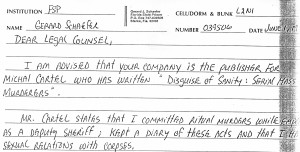
Gerard Schaefer slowed his car along the beach to ask a girl if she wanted a ride home. Always careful riding with strangers, Gerry had the eyes/smile she trusted. Listening to Gerry’s animated stories she never noticed the inside door handle was missing. Now dark, Schaefer turned into a back road.
When the girl didn’t return home, her parents called the police. A report was taken, filed away and eventually thrown out. Until the girl either turned up alive or dead she was just another teen runaway.
Days later Schaefer brought a pair of hitchhiking girls to a swampy, wooded area, tying them to his favorite hanging tree.
Tall and burly, Gerard easily controlling his victims, and as a deputy sheriff he had the perfect ruse. Schaefer smiled, drank wine, fondled his fillet knife and got erotic watching the girls’ agony.
Schaefer wrote remarkably detailed accounts of his murders, especially regarding his euphoria and their terror at each moment of carnage. He also kept personal articles of his guests that included clothing, jewelry or even their teeth. These collections were taken to his mother’s house in Fort Lauderdale where he stored them in a secret trunk.
Psychiatrists tried to untangle the mind of Gerard Schaefer when he was finally brought before the court several years later. A charming, full-blown psychopath, what Schaefer told doctors may or may not have been true, saying that he had many sexual issues (“hangups”) and that as a child his father favored his sister, hated him.
So, Gerry played games that he was a girl and wanted to die. Sometimes, Schaefer said, he’d tie himself to a tree, get sexually aroused and hurt himself (because {he said} of his self-hatred), often while wearing women’s underwear. Soon he felt ecstasy daydreaming only about hurting young women.
Gerry went in several academic directions while attending college after high school in 1964. Settling on nothing he joined a traveling folk-singing religious show that influenced him into seeking the priesthood. Schaefer was rejected/ejected from St. John’s Seminary (for undisclosed reasons) which he said forced him to leave Catholicism.
All this time Schaefer was still consumed with sex-murder fantasies (although he intimated that he was also killing at this point), saying that he actually went to a psychiatrist on his own for therapy without success.
Schaefer next decided to be a public school teacher. Changing his major and working as a student teacher, Schaefer couldn’t help but over-control students with his bizarre belief system. He was soon fired and warned by the supervisor that he would prevent Gerry from having authority over anyone in the future.
Swiftly getting married and divorced, Schaefer decided to take a European/African vacation to sort out his aimless, dangerous life. Returning from the sabbatical, Gerry believed that he could now have the most control over people by becoming a cop.
Gerry failed a psychological test with the Broward County Sheriff’s office but kept applying to other agencies. Schaefer was eventually accepted by the Wilton Manor Police Department, going to work in 1970 after getting schooled in Police Science. But after much incompetence and reportedly being Gestapo-happy and pulling over women for dates, Gerry was discharged by Chief Bernard Scott in half a year.
Gerry evened the playing field for himself and landed a job as deputy sheriff in sparse Martin County. Schaefer presented Sheriff Richard Crowder with an outstanding recommendation from Chief Scott, that was, of course forged.
Schaefer also got married for a second time, seldom showing the violent other side to his new wife that got him divorced the first time.
During and between police assignments, it is believed Schaefer made time to attract and murder dozens of young hitchhiking women, often taking them to empty, beautifully haunting Hutchinson Island.
While playing his favorite execution game, Schaefer wrote (and later talked about) how exciting it is to have two teenage girls tied while threatening to skin them alive. Schaefer teased that he would delay or spare one of them. Gerry then happily played with his skinning knife as each girl made the case why her girlfriend deserved to die so horribly.
Schaefer also sexually violated the corpses of many victims, sometimes coming back later for more romance (like Ted Bundy) when the corpse’s complexion turned porcelain-waxen, fingernails black and frigid bodies maggot-covered.
In mid 1972, while in uniform and driving his squad car, Schaefer picked up two girls hitchhiking. Gerry lectured Nancy Trotter (18) and Pamela Wells (17) on the dangers of hitching, lying that it was also illegal. Saying that he would take them to the beach, Schaefer instead drove to abandoned Hutchinson Island. Craggy tree shadows crept slow with the setting sun as Gerry stopped, pulled his revolver and ordered the girls to his murder tree. He tied a noose around both their necks to the branch and balanced the girls on the large, protruding roots. Schaefer, now excited watching the panicked girls slipping, moments from slow torture. But there was a radio message that Schaefer had to answer and left the girls while he ran to his police car.
Returning, Gerry was horrified that the captives were gone. He called his commander (Sheriff Richard Crowder) saying that he was teaching two runaway girls a lesson by scaring them straight. Trotter and Wells, however were already talking to Crowder at the station with a very different take on the incident.
Getting his aggravated assault and false imprisonment reduced to six months in the joint (if he was good), Schaefer was out on bail when he decided to go bad again. Before starting trial, Gerry returned to his favorite sport (this time) without a police uniform.
In Oakland Park, Susan Place told her mother that she was going to the beach and play guitar with this nice guy named Gerry. Susan’s mother peered at nice guy Gerry in his Datsun and was concerned that her 17-year old daughter was carousing with a man in his late 20s. She was also suspicious enough of his continuous smile to write down his license plate number.
As they drove away, Susan told Schaefer about her girlfriend Georgia Jessup, a year younger, who might like to attend their beach party. Gerard met Georgia at her home where the teenager composed a letter, informing her parents that she was running away, saying that “…I love you both but I have to find my head.”
When Susan Place did not return home, her mother went to the local police. But nothing was done. Since the late 1960s cops were swamped with missing teenage reports, most all were runaways and usually from middle class families. All of the parents claimed child abduction, kidnapping or worse since their girl would never intentionally leave the family. A follow-up report usually found that the teen returned home after a lark or was in fact a runaway. It would be another decade, with the serial murder epidemic, before police would take more seriously the missing teenager reports.
Hearing nothing for a month, Susan’s mother called again to see if the police had run down the plate number she had given them. The car had yet to be identified so Lucille Place worked on her own to locate the registered owner.
After six months, Susan Place’s mother discovered that the missing Datsun was registered to a Gerard John Schaeffer. Finally in county jail, Mrs. Place positively identified Schaefer as the man her daughter had driven off with.
Within the week, hikers came across a scattering of human bones on Hutchinson Island. Cops later collected enough jaw teeth to identify Susan Place and Georgia Jessup. Gerry denied ever knowing Susan and Georgia or harming anyone.
But by now the police had opened Schaefer’s trunk with the diary, the victim’s clothing, personal items, human teeth and other evidence that linked him with Place, Jessup and an unknown number of others.
Place and Jessup had been butchered while tied to the hanging tree, investigators noted. Piecing together his stories, Schaefer writes/talks about how he mutilated two girls alive, one of them choking on her own vomit watching her friend being disemboweled. Schaefer never admitted to the September 27, 1972 murders, so it’s not certain what ordeal the girls had to live through. Susan Place had also been shot in the jaw.
A Public Defender representing Schaefer told the press that his client suffered from a serious mental disorder, quickly adding that he didn’t think that Schaefer committed the murders. While Gerry was still sitting out his abduction sentence, police and prosecutors were busy linking him with perhaps 20 homicides. Hundreds of parents were offering information about their own missing girls. And now the authorities were listening.
Schaefer got a battery of tests from the state mental hospital at Chattahoochee where doctors found Gerry sane to stand trial. Of course he knew what he was doing but preferred to murder rather then battle the urge or get help when he had the chance.
Even as the evidence at his trial made him seem like a monster, Schaefer’s smiling, animated interviews (like Ted Bundy) turned him into a curiosity with the media. While laboring to defend the creepiest of all possible clients, the Public Defender warmed to Schaefer’s wife, now separated from Gerry.
Schaefer’s side of the story was that his trunk filled with items belonging to the deceased (and so much from other dead/missing girls) were coincidental finds and buys or outright gifts. The diary of the murders were just notes for his novel and the drawings of mutilated, hanging, naked, screaming women were art. Newspaper clippings of murders were just ideas for his fiction. Jessup and Place’s identified teeth were a plant by a live-in friend who Schaefer claimed confessed the murders to him. Police soon cleared the ‘confessing’ roommate of any crime.
But Gerry explained away anything/everything else as police lies – And then it was (also?) the Mafia framing him because of a dope related retaliation, then the story morphed into criminal cops angry at Gerry because of their dope deals.
The D.A.’s only problem was perhaps having too much evidence. Schaefer’s secret trunk overflowed with dead people’s possessions. Some skeletal remains were found that matched dental records linking other victim’s teeth and even IDs to Schaefer, but cause of death could not be determined. So many others had driver licenses that also matched dental records but their bodies could not be found. Susan Place did have the bullet wound and her mother identified Schaefer and his car that carried away her daughter and Jessup the day of their disappearance.
So the prosecution went for their strong Susan and Georgia murders to keep Schaefer caged unless (or until) they needed more convictions to keep him locked away for good.
The jury had no trouble following the prosecutor’s case. They were also unmoved by the defendant’s childlike smiles, at turns monstrous sitting behind the defense table. As with the Charles Manson case, the death penalty was not an option, so the jury did what they could, giving Schaefer two concurrent life sentences for the Place-Jessup murders. He was eligible for parole in 2017.
Mrs. Schaefer was granted a divorce as Gerard traveled to Avon Park Correctional Institute in St. Lucie County. The Public Defender fleetly married the ex-Mrs. Schaefer and appealed, unsuccessfully, to an appellate court his client’s conviction. Gerry, smiling as usual, was not happy and planned for revenge and exoneration. First he used his wife’s remarriage (to his lawyer) as another alibi for another appeal. As time wore on, Schaefer filed 19 appeals on his own, all rejected.
In 1985, Schaefer plotted to escape from the Avon Park pen and murder several people on the outside. Gerry was sent to Starke maximum penitentiary (Florida State Prison), home of Ted Bundy and Florida’s electric chair. And that’s the destination where he would eventually get justice.

Ted Bundy (above) allegedly told Schaefer that he did two kills at a time because of reading about Gerry ‘s style.
In a prison interview in 1991, Schaefer spends an hour blaming everyone for everything while exonerating himself. Smiling then smirking, he’s going to punish all who have hurt him; Police, ex-wife, lawyer, judge, media, tricky old girlfriend, turncoat friends. In just 18 years Schaefer has gone from handsome and athletic to obese, balding, elderly and near blind. Most instructive from the tape is actually watching a living monster pose as a human.
But while he was publicly shouting his innocence, Schaefer is also bragging to other inmates that he’s the greatest killer of women. When talking with Ted Bundy or Otis Toole, Gerry is more concerned with his murder count. If a woman dies on her own vomit, Schaefer asked, does that count as a kill? If she’s pregnant, is that good for counting two kills?
Other letters have Schaefer bragging that he began killing at age 19 from 1965 and his murder total was over 80. And he is the only killer who routinely captured and slaughtered two girls at a time. It’s lots harder, he said, but so much more fun. And no one, he allegedly said, is more skilled at hanging (a whore) or cutting off a (slut’s) head (with just two knife strokes).
AFTERWARD
I got a rambling several page letter from Gerard Schaefer addressed to “Legal Council” to my P.O. Box on June 1, 1993.
Schaefer was offended that I said in print he was a murderer, and for that he wanted money for me having damaged his good name.
The letter also had a fool’s list of other complaints where I was first irritated that a genuine monster was threatening me, but soon became intrigued by the reasoning of a sociopath in a personal letter. Then I actually washed my hands after touching the paper that had been handled by Schaefer.
I wrote back that I would not reward him.
A second letter from Schaefer arrived on July 8, saying he would give me 15 days to submit to all his demands before filing a suit against me in Florida, where (he said) the climate of a libeled plaintiff is much more favorable. That’s the last I heard from him.
Much later I read online that Schaefer had sent threats and filed lawsuits against anyone who had written anything about him. All the legal fees and court costs were free to Gerry since he was a prisoner and dead broke. Anyone getting sued had to hire an attorney and go through the legal process at great cost until a magistrate ruled that the case had no merit.
Except me.
By the time I heard (online) that I had been one of those sued, something had happened.
Gerry was also writing thinly veiled poison pen letters threatening ‘accidents’ to his ‘enemies’ (or their children) from his outside hit team. At times his avengers were the ‘southern mafia,’ later it was ‘devil worshipers’ and then ‘con friends’ who owed him favors.
And Schaefer was also running several mail order sex frauds from his jail cell. As soon as authorities stopped one, Gerry introduced a new scam. All this while at max security.
Schaefer was delighted to be in control again; suing everyone; threatening death to those on his get-even murder list; running one fraud scheme after another; loudly bragging about his kill score with details; filing endless appeals for his immediate release, sweet-talking the naïve on the outside to lie for his appeal schemes. And even strutting about his con double-crosses. As psychiatrist Margaret Singer said (regarding {tiresless} serial killer Kenneth Bianchi in prison), “Psychopaths never give up.”
He was also despised by prisoners at Starke. Schaefer was less famous as a killer of little girls than he was famously hated as a snitch. He charged cons for his help as a jailhouse legal advisor, but always probed them to admit guilt and other crimes (as if he had an attorney-client privilege), but then bargained the information with authorities for perks at the other end. One client was sent to death row because of Schaefer’s snitching, having been handsomely paid by both the con (with cash at the start) and rewarded by the prison later.
Serial killers might be accepted (under some rules) by prisoners, but rats never can be.
On November, 1994, while working in the law library, Schaefer was shank-attacked by another inmate resulting in considerable blood flow from several stab wounds to his body, hands and face. As he was recovering, Gerry wrote to the appellate court that because of this attack he was too traumatized to continue his various appeals with nuisance lawsuits.
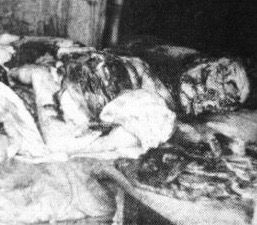 13 months after his near assassination, Schaefer is found in an ocean of even more blood, having been stabbed 42 times, including deep rips to his eyes. He agonized quite horribly before dying. Georgia Jessup’s mother, Shirley said that “I’d like to send a present to the guy who killed him…I just wish it would have been sooner than later.”
13 months after his near assassination, Schaefer is found in an ocean of even more blood, having been stabbed 42 times, including deep rips to his eyes. He agonized quite horribly before dying. Georgia Jessup’s mother, Shirley said that “I’d like to send a present to the guy who killed him…I just wish it would have been sooner than later.”
Schaefer’s final photo shows his butchered face, mutilated eyes with a ghoulish frown. The only picture Gerry ever took where the monster wasn’t smiling.
Disguise of Sanity 1985, booklength nonfiction. Revised/updated 2016 third edition
NOW on KINDLE AMAZON
CLICK ON: DISGUISE of SANITY on KINDLE

